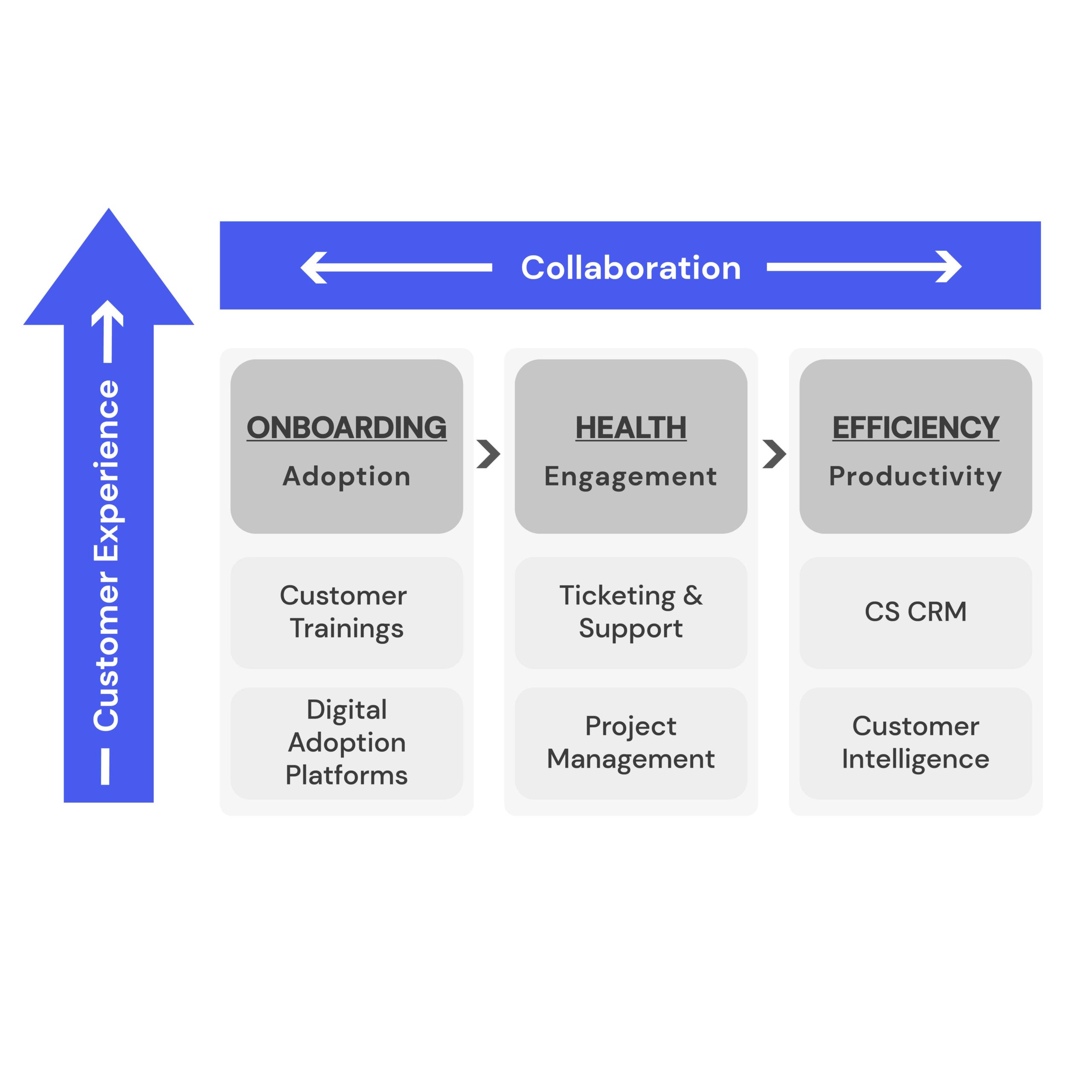 BACK TO BLOG
BACK TO BLOG
How to build a Customer-Centric CS tech stack in 2022?

 BACK TO BLOG
BACK TO BLOG

Ask any revenue leader, and they’d tell you that collaboration is the secret sauce to creating a “delightful customer experience”! With B2B organizations increasingly viewing customer success as an “offensive growth tactic,” a seamless customer experience aligning with customer needs will be critical for growth in the post-pandemic business reality.
But, what is the significance of a collaborative experience in your CS strategy?
Let’s pick an example from the consumer world: you want to subscribe to a “healthy” meal delivery service. While battling uphill questions about calories, meal portions, cancellation charges, and refund policies, searching for relevant information cluttered in bits and pieces is the last thing you’d want. On the contrary, a particular vendor offers easy accessibility, discoverability, and a guided buying experience of relevant and personalized information in a single workflow to help you decide what to eat every time you are hungry. Wouldn’t you return to avail more services from them? We bet you will!
After all, what’s not to like about a service provider who intently understands your needs and helps you achieve the outcomes!
In the last 24 months, we saw the pandemic hit and turn the world upside down- it transformed the way we connected with customers while ramping up the digital momentum. Further, the “stay-at-home” orders and increased remote purchases catalyzed a drastic change in customer success trends and behavior.
B2B organizations could not escape the intense jolt of the pandemic, as they had to re-design their approach to understand customer needs afresh. Extensive exposure to digital channels, services at the comfort of your home, and ease of online purchases have annexed an irreversible set of buyer expectations forcing organizations to adapt to the unwritten rules of the changing B2B landscape.
Customer success leaders face a formidable question in this new world order: "What tech stack should I choose to retain and grow customer accounts? At first glance, it might seem like a relatively straightforward decision: identify the tools that best cater to your business needs in terms of efficiency and scalability, and you’re good to go! But it’s easier said than done.
Your tech stack influences not just your everyday operations but also determines the way your customers view you, which is why it is essential you hand-pick the tools that align with you and your customer’s desired outcomes.
Customer success is a multi-facet growth engine that will help you improve customer value and net retention rate.
Today, businesses interact with customers through myriad communication channels, so much so that a seamless collaboration has become the epicenter of the B2B sales and CS strategies. Viewing digital engagement as one of the three primary focus areas in the Covid customer experience era, McKinsey&Co plans to extend its post-pandemic investments.
This blog has categorized the CS tech stack into four major buckets. Let's take a comprehensive look at why and how some of these tools miss out on creating an ideal customer experience.

Adoption
Nothing compares to the incredible feeling when new customer users start using your product! But do you know how many will stick around and become your power users in the long haul? Or even use the product extensively?
User adoption is an uphill climb for organizations as we come across countless stories of implementation failures leading to customer churn. The first step in creating a delightful customer experience should begin as your customers integrate your product into their daily workflow and get the first value.
And so, while you may have an excellent product, a siloed adoption strategy will do you more damage than good!
There are countless customer adoption platforms in the marketplace; nevertheless, only a handful of tools solve for a frictionless collaboration. Docebo, LearnUpon, and other customer training platforms unify the training delivery to fuel your customer success; these platforms miss out on providing an integrated knowledge check with limited collaborative features. Whatfix and Appcues may be the pioneers in facilitating product announcements and user-onboarding experience essential for adoption from end-users; nonetheless, your power users need a more collaborative and connected experience to know where they are in value realization.
Another problem to tackle in order to drive adoption is streamlining the implementation of your offering with a new customer. Traditionally, many customer success teams use general-purpose project management tools like Asana or Clickup. Having a purpose-built platform (like BuyerAssist) that has a deep focus on success planning and collaboration will be critical in your efforts to accelerate time to value for your new customers.
So while the modern adoption tools may encourage customers to use your products, integrate the latest KPIs and dashboards, and track product usage, these hit the skids in providing a real-time unified view for all stakeholders. A user adoption experience built without actively collaborating with your power users and champions will lead to suboptimal adoption among end-users, further impacting the customer experience and increasing the likelihood of churn.



Let's take this scenario: Your customer success manager has built a great rapport with your customer champion, but as you approach the renewal discussion, your champion leaves the customer organization leaving your CSM to nurture someone new to become a champion. All the great QBR decks and success stories are lost in emails and text messages. What does your CSM do?
There needs to be a well-defined strategy to engage both the power users and end users as you think about engagement.
While customer users can real-time connect with support services via Intercom, Zendesk, or Freshdesk, these platforms focus on reactive issues, fixes, and communication. On the other hand, communication tools like Slack and MS Teams might allow you to connect in real-time with your power users, and on their terms, documenting interactions in the never-ending clutters of emails and texts remains a problem.
Asana and Monday.com offer intuitive project management features, communication gaps leading to scant accountability remain a formidable challenge for the power users of these platforms.
The modern customer engagement approach should be digital-first, customer transparent, and easy to manage for mutual growth of you and your customers.
Do you think the customer engagement platforms address these customer-facing challenges?
As the pendulum swings toward customer centricity, digital-first collaboration is fundamental for improving your customer success in the long run. With the ongoing virtual momentum, you’ll only be able to retain customers longer if you're “on the same side” as your customers, which is only possible with active mutual collaboration.
Modern customers want to see continuous value in their CS journey. When you enhance productivity from the standpoint of not just "automating things" but also elevating the customer experience, you're winning loyalists for the long haul! But, how would you measure customer-centric KPIs with ongoing customer success changes?
Customer Success CRM platforms like Gainsight, Totango, and Catalyst are great at keeping track of your account health; their focus is on managing internal reporting and compliance between CSM and customers, But they fail to facilitate a CRM is supposed to be about: customer relationships. As a result, our customers are left with an ad-hoc experience as they go from QBR to QBR with limited visibility on value realized.
Customer intelligence tools like Amplitude and Pendo provide user analytics and product usage data with a real-time view of every customer action; however, the focus remains limited to the internal analysis of already gathered information.
Unfortunately, there are critical gaps in the tech stack to guide customer experience and value realization despite significant innovations. For example :
With in-person interactions on hiatus, the rules for customer experience have changed completely! As the remote working model becomes a permanent fixture, organizations need to be more thoughtful in creating effective collaborative approaches to retain and grow customers.
Customer collaboration has been abuzz for some time now; it has become even more critical in a post-pandemic setting. Yet, most B2B organizations continue to overlook collaboration, especially now with "digital-first customers."
In this blog, if you would’ve observed closely, you'd notice that:
The traditional CS tech stack has one significant limitation- it fails to cater to the modern customer preferences of outcome-oriented, self-service, and digitally collaborative relationships.
How? Let's understand this with one of the most critical CS responsibilities - Customer QBRs.
The Quarterly Business Reviews (QBRs) help customer success teams showcase to their customers why and how their product or service adds value to their business. It is also a place where you align on the future goals and what needs to be done to get there. However, it is essential to note that it is grueling to keep track of promises made and promises delivered in QBR after QBR, and they end up getting lost in the countless emails, notes, and documents.
If you have many CSMs managing enterprise customers, how do you ensure your team captures the right insights from the QBRs and delivers on the same for the customer? Also, how do you reinforce all the wins from the previous QBR discussions at the time of renewal or upsell? More often than not, these are manual processes, and they lack trackability.
Just like CRM systems enable CSMs and sales teams to document everything for the leadership team needs to plan accurately, there is a need to bring everything together for customers in one place too.
Modern customer collaboration platforms like BuyerAssist:
When you integrate everything into a single platform, align your goals, and view experiences from the customer’s perspective, you're likely to make more than a sale…Voila! You're likely to have found yourself a life-long customer!
Winning a hard-fought deal is just the tip of the iceberg; the post-sales aftermath of customer retention and tangible value realization falls squarely on CS. Modern customer success isn’t just a checklist of tasks that you can proceed through overnight or an organization function limited to reactive issues responding. It is a growth function that accelerates value delivery, keeps your customers happy, and helps you grow customers.
The shift to remote first has put incredible pressure on customer champions to show measurable value for their investments. In turn, they’re looking at vendors to make it easy for them to connect the dots in their journey. What modern customers want is a connected and transparent digital experience to get on-demand access to the status of outcomes, milestones, and value realization. This shared visibility will allow your CS teams to partner with customers and succeed together!
To do this successfully, CS leaders need to build an intuitive customer-facing tech stack that allows them to foresee challenges, drive accountability, and engage better with their customers. Even if your customer success team is in its infancy, an agile customer-oriented tech stack will help you effectively tap into customer insights right where it should.
When you fine-tune your strategies by placing the customer journey at the heart of your CS playbooks, you’re not only winning revenue prospects but creating product evangelists for life!






